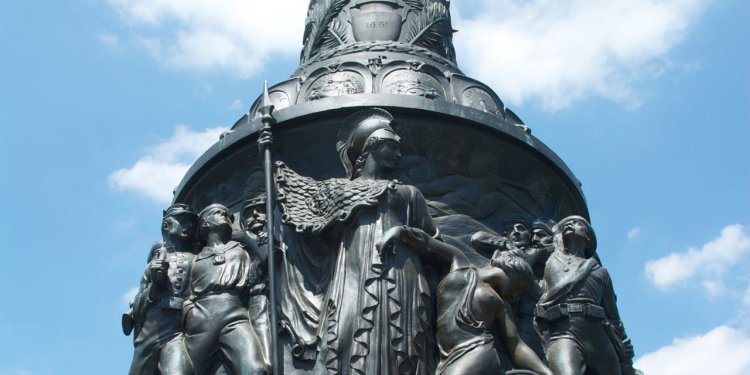Save the Confederate Memorial at Arlington
A commission will tear down this monument to national healing by year’s end if we don’t act. By Jim Webb Aug. 18, 2023 3:23 pm ET In 1898, 33 years after the end of the Civil War, the Spanish-American War brought a sudden, unanticipated harmony and unity to a country that had been riven by war and a punitive postwar military occupation, which failed at wholesale societal reconstruction. In the South, American flags flew again as the sons of Confederate soldiers volunteered to fight, even if it meant wearing the once-hated Yankee blue. President William McKinley presciently seized this moment to mend a generation’s sectional divide. The Confederate Memorial in Arlington, Va. April 12, 2012. Photo: Mark Reinstein/MediaPunch/IPx McKinley understood the Civil War as one who had lived it, having served four ye

In 1898, 33 years after the end of the Civil War, the Spanish-American War brought a sudden, unanticipated harmony and unity to a country that had been riven by war and a punitive postwar military occupation, which failed at wholesale societal reconstruction. In the South, American flags flew again as the sons of Confederate soldiers volunteered to fight, even if it meant wearing the once-hated Yankee blue. President William McKinley presciently seized this moment to mend a generation’s sectional divide.

The Confederate Memorial in Arlington, Va. April 12, 2012.
Photo: Mark Reinstein/MediaPunch/IPx
McKinley understood the Civil War as one who had lived it, having served four years in the 23rd Ohio Infantry, enlisting as a private and discharged in 1865 as a brevet major. He knew the steps to take to bring the country fully together again. As an initial signal, he selected three Civil War veterans to command the Cuba campaign. Two, William Rufus Shafter, given overall command of the Cuban operation, and H.W. Lawton, who led the Second Infantry Division, the first soldiers to land in the war, had received the Medal of Honor fighting for the Union. The other, “Fighting Joe” Wheeler, the legendary Confederate cavalry general, led the cavalry units in Cuba, after being elected to Congress in 1880 from Alabama and working hard to bring national reconciliation.
Four days after the Spanish-American war ended, McKinley proclaimed in Atlanta: “In the spirit of fraternity we should share with you in the care of the graves of Confederate soldiers.” In that call for national unity the Confederate Memorial was born. It was designed by internationally respected sculptor Moses Jacob Ezekiel, a Confederate veteran and the first Jewish graduate of the Virginia Military Institute, who asked to be buried at the memorial in Arlington National Cemetery. On one face of the memorial is the finest explanation of wartime service perhaps ever written, by a Confederate veteran who later became a Christian minister: “Not for fame or reward, not for place or for rank; not lured by ambition or goaded by necessity; but in simple obedience to duty as they understood it; these men suffered all, sacrificed all, dared all, and died.”
But now in this new world of woke, unless measures are taken very soon, by the end of this year the Confederate Memorial will be gone.
With surprising overbroadness, the 2021 National Defense Authorization Act, passed in the midst of national racial and political upheaval, empowered a Naming Commission to “remove all names, symbols, displays, monuments and paraphernalia that honor or commemorate the Confederate States of America . . . or any person who served voluntarily with the Confederate States of America from all assets of the Department of Defense.” As part of that provision, Arlington National Cemetery has been ordered by Defense Department officials to remove the memorial by the end of this year, though the order is reportedly under review.
Having spent four years as a full committee counsel in the House and six years as a member of the Senate Armed Services Committee, I cannot imagine that the removal of this memorial, conceived and built with the sole purpose of healing the wounds of the Civil War and restoring national harmony, could be within the intent of a sweeping sentence placed inside a nearly trillion-dollar piece of legislation.
The larger and ultimate question reaches further into America’s atrophied understanding of the Civil War itself. What was it that Union Army veteran McKinley understood about the Confederate soldiers who opposed his infantry units on the battlefield that eludes today’s monument smashers and ad hominem destroyers of historical reputations?
McKinley’s fellow soldiers understood that during the Civil War, four slave states remained in the Union—Maryland, Delaware, Missouri and Kentucky—and none of them were required to give up slavery during the entire war. And that in every major battle of the Civil War, slave owners in the Union Army fought against non-slave-owners in the Confederate Army. They understood that President Lincoln’s Emancipation Proclamation did not free the slaves in those states or in the areas of the South that had already been conquered. The proclamation freed only slaves in the areas taken after it was issued. And in the eyes of a Confederate soldier, if Lincoln had not freed slaves in the union, why should the soldier be vilified for supposedly fighting on behalf of slavery?
Many soldiers in the North, and many more in the South, would have understood what John Hope Franklin
(1915-2009), America’s most esteemed black historian, pointed out: In 1860 only 5% of whites in the South owned slaves, and less than 25% of whites benefited economically from slavery. An estimated 258,000 Confederate soldiers died in the war, about a third of all those who fought for the South. Few owned slaves. So why did they fight?The soldier who wrote the inscription on the Confederate Memorial knew. And so did President McKinley and most veterans who have fought in America’s wars.
In 1992, as a private citizen and veteran of the Vietnam War, I was seeking to begin a process of reconciliation with our former enemy and hosted a delegation of Vietnamese officials in Washington. One of my objectives was to encourage Hanoi finally to make peace with the South Vietnamese veterans who had fought against the North and who after the war were labeled traitors, denied any official recognition as veterans, and hundreds of thousands were imprisoned in re-education camps.
To make my point I brought them to the Confederate Memorial. Pointing across the Potomac River from Arlington National Cemetery toward the Lincoln Memorial, I told them the story of how America healed its wounds from our own Civil War. The Potomac River was like the Ben Hai
River, which divided North and South Vietnam. On the far side was our North, and here in Virginia was our South. After several bitter decades we came together, symbolized by the memorial.If it is taken apart and removed, leaving behind a concrete slab, the burial marker of its creator, and a small circle of graves, it would send a different message, one of a deteriorating society willing to erase the generosity of its past, in favor of bitterness and misunderstanding conjured up by those who do not understand the history they seem bent on destroying.
Mr. Webb was a Marine infantry officer in Vietnam, Navy secretary (1987-88) and a U.S. senator from Virginia (2007-13). He is the distinguished fellow at Notre Dame’s International Security Center.
What's Your Reaction?

















